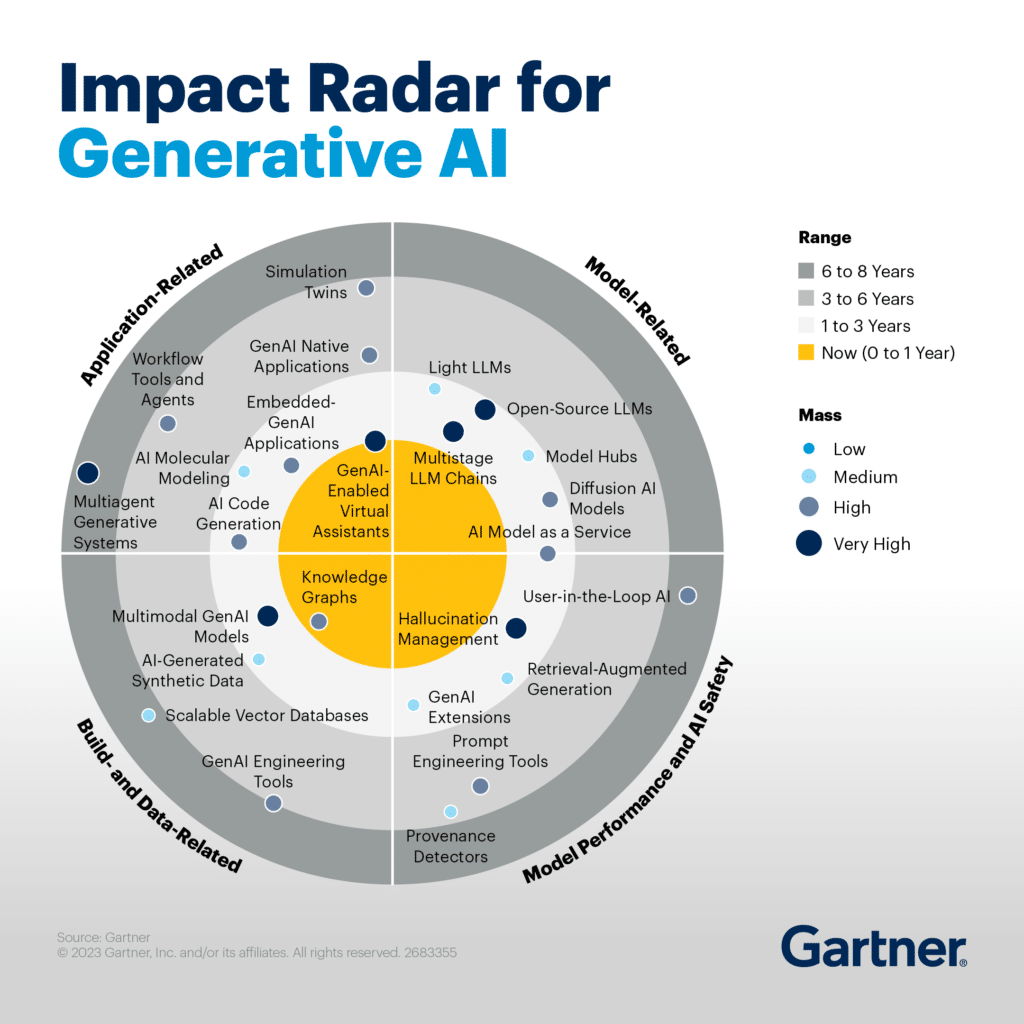
Director Client Data Solutions

Data & AI Evangelist
Subscribe to the newsletter
With the massive hype around generative AI adoption, now is the high time for businesses to make the most out of gen AI across various domains. Despite being on everyone’s radar, only 10% of organizations are experimenting with gen AI, while 62% plan to increase their spending on generative AI. As the launch of ChatGPT has caused a massive buzz, organizations are continuously trying to keep up with the pace and the untapped potential of this intelligent technology. The good news? It’s not too late for business leaders to leverage generative AI to capture its value and pull ahead in the competition.
The applications of generative AI are endless, from automating daily tasks to generating creative content and beyond. While many business leaders recognize this technology’s transformative potential, they often feel unsure how to integrate it into their operations.
Whether you are hesitant to start your generative AI journey, have faced challenges with adoption in the past, or are seeking a generative AI roadmap for your journey, we’ve prepared a comprehensive guide to help you get started.
It all starts with a generative AI strategy
A generative AI strategy outlines how an organization will use generative AI technologies to achieve specific goals. It includes defining objectives, identifying relevant use cases, selecting appropriate tools, integrating AI into existing systems, and addressing data management, skills, and ethical considerations. The strategy ensures effective implementation and maximizes the benefits of generative AI.
Still trying to figure out where to start? Take a look at the Gartner impact radar to guide your investment decisions and shape your strategy. With the radar’s analysis, you can identify the most promising opportunities, anticipate potential challenges, and align your strategy with the areas where AI will have the greatest impact.

How to get started with generative AI journey: A step-by-step roadmap to take
Given the vast possibilities of generative AI, starting your journey can feel overwhelming. It’s advisable to focus on a specific domain that could benefit from this technology. Instead of pursuing large-scale projects, begin with smaller, manageable initiatives. This approach reduces risks and facilitates a more targeted and effective adaptation.
Now let’s dive into the steps to get you started with your generative AI journey with confidence and clarity.
1. Start by setting up goals for your business
When it comes to setting generative AI goals, it’s important to align them with your organization’s bigger picture. Think about what your business aims to achieve— enhancing customer experience, boosting efficiency, or sparking innovation. Besides incremental benefits, focus on how generative AI can truly revolutionize your business. This could mean anything from finding new revenue streams to changing how the bigger decisions are made.
You could also bring in key players from across your organization to discuss what they hope to achieve with Gen AI. Remember, success isn’t just about the technology, it’s about how it helps you achieve your business objectives.
2. Pin down your generative AI use cases
Once you know what problem you want to solve and what you want to achieve, it’s time to dive deep into your generative AI use case. Start by evaluating how realistic it is to integrate generative AI into your existing systems. Whether you need to build a custom model or a pre-trained one, make sure to know your need for your generative AI business idea. Select the use case that can be addressed by generative AI. Not all AI projects are created equal. Some will make a bigger impact than others. Let’s weigh the pros and cons and choose the most promising one.
Once you’ve picked a particular use case, map out a technical proof of concept (PoC). This should cover everything from data preparation and model selection to how it will integrate with your current systems and how you’ll measure its success.
3. Bring stakeholders on board early
Get your key team members and stakeholders involved from the start. Their input will be invaluable in shaping your generative AI journey and ensuring everyone’s on the same page. It’s about building a shared vision and getting buy-in to make the project smoother and more successful.
You can hire different key members for your gen AI project who can deliver a high-impact, value-driven gen AI solution. Each role will bring unique expertise to the table and play an important role in ensuring that your generative AI project is well-rounded and effective. These include:
- A Gen AI Strategist who aligns AI initiatives with business outcomes.
- A Gen AI Application Engineer who focuses on integrating and deploying generative models seamlessly.
- A Gen AI Model Developer who fine-tunes and trains models for high-quality, context-aware outputs.
- A Prompt Engineer who optimizes the interaction between users and models, leveraging techniques like RAG to enhance AI responses.
- A Data Pipeline Architect who designs robust data pipelines, ensuring that generative models are continuously fed with relevant, well-prepared data.
4. Choose the right foundation model for your needs
Pick a foundation model that best fits your specific use case. This involves finding a model that aligns with what you’re trying to achieve and works well with the data you have. Whether you require a text-generation model, i.e., Large Language Model (LLM), image generation model, i.e., Generative Adversarial Network (GAN), or any other foundation model in generative AI, choose a generative AI model that sets a strong base for your AI project and helps you get the results you’re aiming for.
5. Train and test your generative AI model
Train your gen AI model with your data to get it up to speed. Then, put it through rigorous testing to check how well it performs and ensure it meets your compliance standards. This step is about refining the model to ensure it performs as intended, delivers accurate results, and adheres to necessary regulations before rolling it out more widely.
6. Roll out your gen AI model
After successful training and testing, it’s time to roll out your model! Put it into action in your real-world environment and start using it to solve the problems you’ve been working on. Work closely with your IT team and developers to bring your trained model into your live systems. Developers will ensure everything scales properly so the model fits your business needs well and provides great user experience.
For ongoing improvement, keep the feedback loops open with both users and your technical team. Listen to what users think about the AI. Ask your tech team for their ideas. This feedback will help you make the AI even better over time.
7. Continue scaling and evolving
Once your model is up and running smoothly, it’s time to take it to the next level. Focus on expanding its use across different business areas and adapting it as your needs change. This means scaling up to handle more data or users and continuously evolving the model to keep up with new challenges and opportunities.
As you do this, maintain strong governance practices to ensure everything remains secure, ethical, and compliant. This will help you manage your growing AI capabilities effectively and responsibly.
Take the next steps on your generative AI journey with Confiz
As more businesses see the potential of generative AI, getting started on the right foot is imperative for making the most of this powerful technology. Our Gen AI Kickstart Program is designed to help you do just that. Over eight weeks, you’ll work with our experts to explore the possibilities of generative AI, build a solid proof of concept (PoC), and take your first steps toward your generative AI venture.
This guide sets you up for success by showing how generative AI can drive innovation and give you a competitive advantage. As you continue, keep these core principles in focus:
- First, ideate, assess, and select the right use case for your gen AI solution based on its impact and feasibility.
- Second, prioritize ethics at the forefront of AI development to ensure your innovations are both responsible and sustainable.
- Third, encourage a culture of learning and growth to help your team stay ahead in this rapidly evolving field.
- Lastly, adaptability is crucial. Generative AI technologies and best practices are always evolving, so staying flexible will be key to your long-term success.
By sticking to these core values, you will be positioned to make the most of Generative AI. Ready to bring generative AI transformation to your business? Reach out to us at marketing@confiz.com to learn more about our services or kickstart your Gen AI journey.



